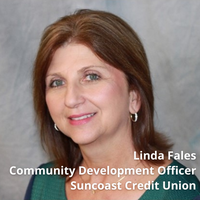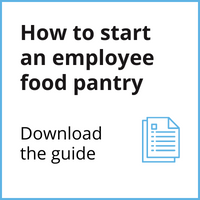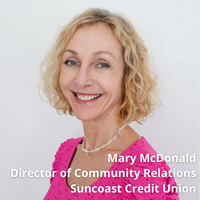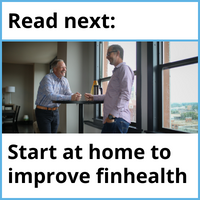What community data says about employee financial health

At Florida’s Suncoast Credit Union, one simple question revolutionized how employees access support to help improve their financial well-being.
 Linda Fales, community development officer at Suncoast Credit Union in Tampa, was in the thick of managing a snack drive to replenish pantries at local schools.
Linda Fales, community development officer at Suncoast Credit Union in Tampa, was in the thick of managing a snack drive to replenish pantries at local schools.
As a graduate of the National Credit Union Foundation’s Development Education (DE) program, she focused on ways to increase and expand the credit union’s impact beyond financial solutions. On this day, as she boxed and bagged with co-workers, a question flashed through her mind, “Do our employees need this kind of help too?”
“I realized if the stats about our community were right, it wasn’t just members who were struggling,” said Fales. “It was my friends and colleagues, too.”
Fales asked the question to Mary McDonald, director of community relations – another DE graduate. The two put together a business case for an employee food pantry. After some initial surprise at the request, credit union leadership approved the plan, and a vacant room was turned into a pantry.
“Once we had the space, we just needed to stock it,” said Fales. “We posted a request for food donations on the intranet, and it flooded in.”
Follow the data
 As the pair began fielding requests for food assistance, they realized employees using the pantry likely needed additional support, too.
As the pair began fielding requests for food assistance, they realized employees using the pantry likely needed additional support, too.
“It seems obvious because the data was always there,” added McDonald. “But we had to make the connection. Pretty quickly after launching the pantry, we began laying the groundwork for a broader support network. We made sure employees knew we were here for them if they had any challenges.”
Their analysis of the data was right: employees started reaching out, and Fales and McDonald found themselves referring colleagues to a network of local service agencies. That soon morphed into researching and creating a statewide, county-by-county online database.
“It was a big effort,” McDonald acknowledged. “But once it was up and running, it doesn’t take a lot of maintenance and it’s an invaluable resource—for employees and members too.”
More than just a pantry
 The better they got to know employees, the more opportunities Fales, McDonald and their teams saw to help their peers.
The better they got to know employees, the more opportunities Fales, McDonald and their teams saw to help their peers.
In 2020, Suncoast expanded the food pantry into a more comprehensive employee resource center. Now, in addition to the pantry and the online resource guide, employees can tap into extensive financial education resources.
One thing that surprised both Fales and McDonald was the range of employees using the resources. “We’ve helped people from every income level and almost every part of our organization,” said Fales. “Just one disaster can put people where they never thought they’d be.”
Employee response and future plans
 Staff support for the employee resource center is strong and growing. Multiple departments have done fundraisers—the call center’s recent “Nachos and Cheese Day” raised over $600. Rather than just send in a check, Fales and McDonald urge departments to shop for the center. “It’s so much more meaningful to take that final step and see what you’ve accomplished,” said Fales.
Staff support for the employee resource center is strong and growing. Multiple departments have done fundraisers—the call center’s recent “Nachos and Cheese Day” raised over $600. Rather than just send in a check, Fales and McDonald urge departments to shop for the center. “It’s so much more meaningful to take that final step and see what you’ve accomplished,” said Fales.
Based on employee feedback, their future strategy includes enabling staff to make regular contributions to the foodbank out of their paychecks.
“We are also looking towards the next phase, which is the possibility of opening the pantry to smaller credit unions,” said Fales.
“It’s pretty amazing where this little nugget of an idea has taken us. Now we hope it inspires other credit unions to ask the same question.”



